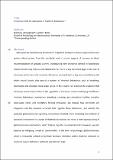A common role for astrocytes in rhythmic behaviours?
Abstract
Astrocytes are a functionally diverse form of glial cell involved in various aspects of nervous system infrastructure, from the metabolic and structural support of neurons to direct neuromodulation of synaptic activity. Investigating how astrocytes behave in functionally related circuits may help us understand whether there is any conserved logic to the role of astrocytes within neuronal networks. Astrocytes are implicated as key neuromodulatory cells within neural circuits that control a number of rhythmic behaviours such as breathing, locomotion and circadian sleep-wake cycles. In this review, we examine the evidence that astrocytes are directly involved in the regulation of the neural circuits underlying six different rhythmic behaviours: locomotion, breathing, chewing, gastrointestinal motility, circadian sleep-wake cycles and oscillatory feeding behaviour. We discuss how astrocytes are integrated into the neuronal networks that regulate these behaviours, and identify the potential gliotransmission signalling mechanisms involved. From reviewing the evidence of astrocytic involvement in a range of rhythmic behaviours, we reveal a heterogenous array of gliotransmission mechanisms, which help to regulate neuronal networks. However, we also observe an intriguing thread of commonality, in the form of purinergic gliotransmission, which is frequently utilised to facilitate feedback inhibition within rhythmic networks to constrain a given behaviour within its operational range.
Citation
Broadhead , M J & Miles , G B 2021 , ' A common role for astrocytes in rhythmic behaviours? ' , Progress in Neurobiology , vol. 202 , 102052 . https://doi.org/10.1016/j.pneurobio.2021.102052
Publication
Progress in Neurobiology
Status
Peer reviewed
ISSN
0301-0082Type
Journal item
Description
Authors acknowledge the Motor Neurone Disease (MND) Association UK (Miles/Apr18/863-791) and the Biotechnology and Biological Sciences Research Council (BBSRC; BB/M021793/1) for their funding and support.Collections
Items in the St Andrews Research Repository are protected by copyright, with all rights reserved, unless otherwise indicated.

